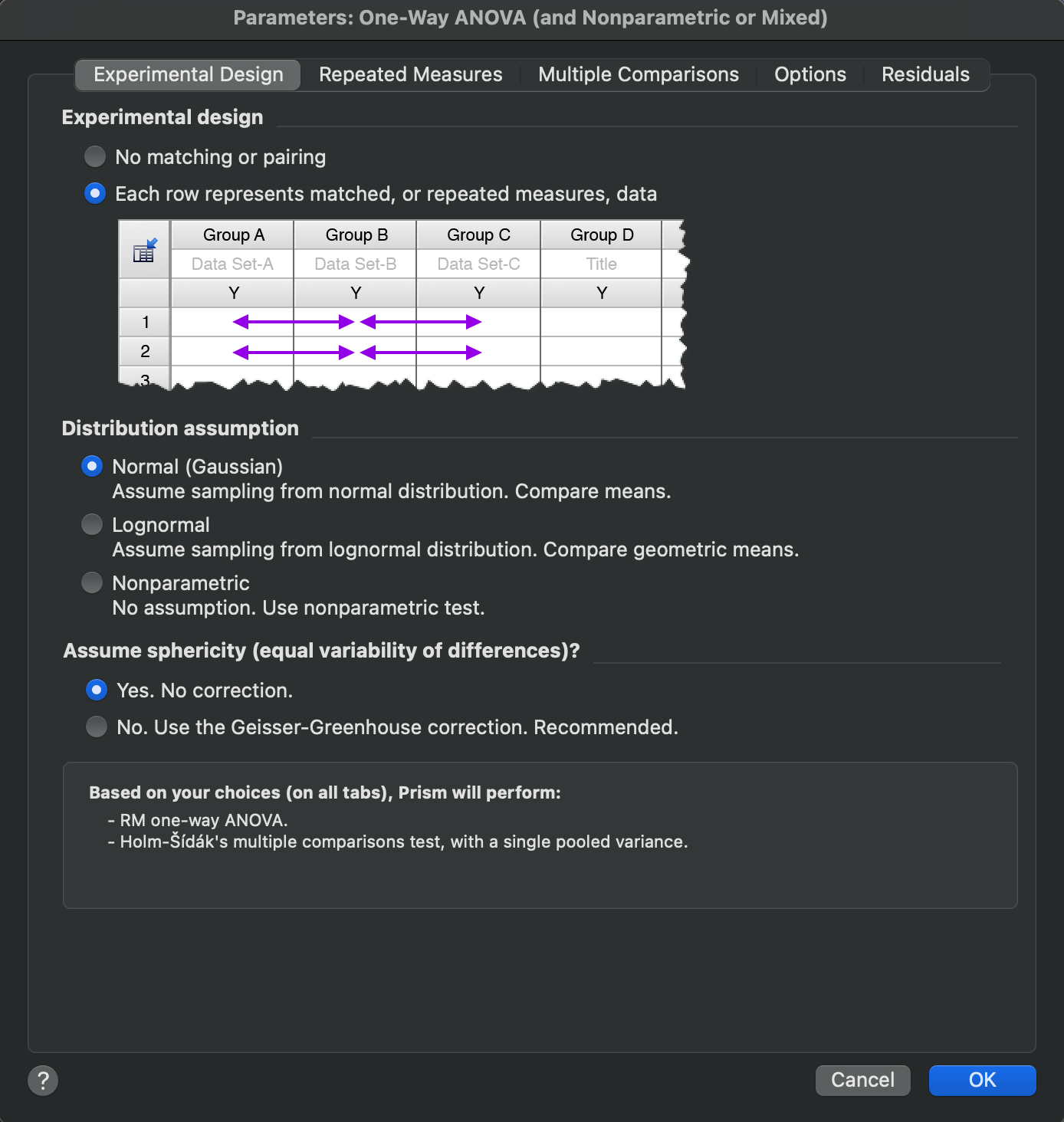Prism offers multiple related tests that compare three or more groups. Your choice of a test depends on these choices:

Experimental Design
Choose a repeated measures test when the columns of data are matched. Here are some examples:
•You measure a variable in each subject several times, perhaps before, during and after an intervention.
•You recruit subjects as matched groups, matched for variables such as age, ethnic group, and disease severity.
•You run a laboratory experiment several times, each time with several treatments handled in parallel. Since you anticipate experiment-to-experiment variability, you want to analyze the data in such a way that each experiment is treated as a matched set.
Matching should not be based on the variable you are comparing. If you are comparing blood pressures in three groups, it is OK to match based on age or zip code, but it is not OK to match based on blood pressure.
The term repeated measures applies strictly when you give treatments repeatedly to one subject (the first example above). The other two examples are called randomized block experiments (each set of subjects is called a block, and you randomly assign treatments within each block). The analyses are identical for repeated measures and randomized block experiments, and Prism always uses the term repeated measures.
Choose "no matching" if you have a completely randomized design.
Distribution assumption
Many statistical analyses have certain assumptions about the populations from which the data being analyzed were sampled. One of the common assumptions that tests will make will relate to the distributions of these populations from which the data were sampled. Prism offers three choices:
1.Normal (Gaussian) - assume sampling from a normal distribution. Compare the means of the groups
2.Lognormal - assume sampling from a lognormal distribution. Compare the geometric means of the groups
3.Nonparametric - do not assume that the data were sampled from a specific distribution. Instead, use a nonparametric tests. This often equates to comparing the ranks of the data within the groups
Nonparametric tests are not based on the assumption that the data are sampled from a Gaussian distribution (or any other specific distribution for that matter). This may make them seem more desirable. However, nonparametric tests have less power. Deciding when to use a nonparametric test is not straightforward.
If no matching: Assume equal variance (homoscedasticity)?
One assumption underlying the usual ANOVA F test is homogeneity of variance. That means that each group is sampled from populations with the same variance. For data sampled from a normal distribution, this means that the populations would have the same standard deviation even if the means differ. For data sampled from a lognormal distribution, this means that the populations would have the same geometric standard deviation even if the geometric means differ.
Starting with Prism 8, you choose whether or not to assume equal population variances. If you choose not to make that assumption, Prism performs two alternative forms of ANOVA and reports both results. Both Welch's ANOVA and Brown-Forsythe ANOVA adjusts the calculations of the F ratio and degrees of freedom to adjust for heterogeneity of within-group variances. The P value can be interpreted in the same manner as in the analysis of variance table.
Notes:
•Why use these special forms of ANOVA rather than use a nonparametric Kruskal-Wallis test? Because while the Kruskal-Wallis test does not make any assumptions about the distributions that the data were sampled from, it does assume that the dispersion or spread of the distributions are the same.
•As an alternative to these tests, consider transforming your data (reciprocals, etc.) and analyzing the transformed values with ordinary ANOVA.
•This Brown-Forsythe test to compare means is distinct from another test also named Brown-Forstyhe that compares variances.
If repeated measures: Assume sphericity?
The concept of sphericity
The concept of sphericity is tricky to understand. Briefly it means that you waited long enough between treatments for any treatment effect to wash away. This concept is not relevant if your data are not repeated measures, or if you choose a nonparametric test.
For each subject subtract the value in column B from the value in column A, and compute the standard deviation of this list of differences. Now do the same thing for the difference between column A and C, between B and C, etc. If the assumption of sphericity is true, all these standard deviations should have similar values, with any differences being due to chance. If there are large, systematic differences between these standard deviations, the assumption of sphericity is not valid.
How to decide whether to assume sphericity
If each row of data represents a set of matched observations, then there is no reason to doubt the assumption of sphericity. This is sometimes called a randomized block experimental design.
If each row of data represents a single subject given successive treatments, then you have a repeated measures experimental design. The assumption of sphericity is unlikely to be an issue if the order of treatments is randomized for each subject, so one subject gets treatments A then B then C, while another gets B, then A, then C... But if all subjects are given the treatments in the same order, it is better to not assume sphericity.
If you aren't sure, we recommend that you do not assume sphericity.
How your choice affects Prism's calculations
If you choose to not assume sphericity, Prism will:
•Include the Geisser-Greenhouse correction when computing the repeated measures ANOVA P value. The resulting P value will be higher than it would have been without that correction.
•Quantify violations of sphericity by reporting epsilon.
•Compute multiple comparisons tests differently.
If you ask Prism to assume sphericity, but in fact that assumption is violated, the P value from ANOVA will be too low. For that reason, if you are unsure whether or not to assume sphericity, we recommend that you check the option to not assume sphericity.